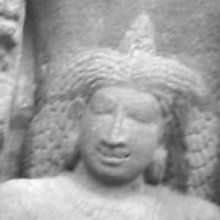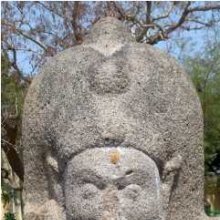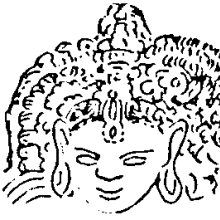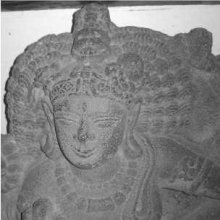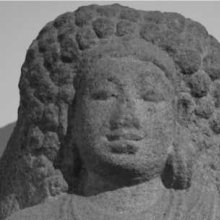Jatabhara, Jata-bhara, Jaṭabhāra: 9 definitions
Introduction:
Jatabhara means something in Hinduism, Sanskrit, Marathi. If you want to know the exact meaning, history, etymology or English translation of this term then check out the descriptions on this page. Add your comment or reference to a book if you want to contribute to this summary article.
Images (photo gallery)
In Hinduism
Shilpashastra (iconography)
Source: Google Books: The Book of Hindu Imagery: Gods, Manifestations and Their MeaningJatabhara—(Variation of Shiva’s hairstyle) The word means “burden of braids” and the hairstyle is usually characterized by a large number of penitential plaits worn in a bunch on the side, as in Shiva-Dakshina-Murti.

Shilpashastra (शिल्पशास्त्र, śilpaśāstra) represents the ancient Indian science (shastra) of creative arts (shilpa) such as sculpture, iconography and painting. Closely related to Vastushastra (architecture), they often share the same literature.
Purana and Itihasa (epic history)
Source: valmikiramayan.net: Srimad Valmiki RamayanaJaṭābhāra (जटाभार) refers to a “mass of matted hair”, according to the Rāmāyaṇa chapter 2.28. Accordingly:—“[...] soothening with kind words to Sītā, when eyes were blemished with tears, the virtuous Rāma spoke again as follows, for the purpose of waking her turn back: ‘[...] Oh, Sītā the princess of Mithila! Fasting is to be done according to one’s stamina. Clothes of bark are to be worn and mass of matted hair (jaṭābhāra) has to be worn on the head’”.

The Purana (पुराण, purāṇas) refers to Sanskrit literature preserving ancient India’s vast cultural history, including historical legends, religious ceremonies, various arts and sciences. The eighteen mahapuranas total over 400,000 shlokas (metrical couplets) and date to at least several centuries BCE.
Languages of India and abroad
Marathi-English dictionary
Source: DDSA: The Molesworth Marathi and English Dictionaryjaṭābhāra (जटाभार).—m (S) A mass of matted locks tufted on the crown. Ex. ja0 bāḷagalyānēṃ sādhutva yēta nāhīṃ; sāvaruniyā ja0 || vari mukuṭa ghātalā sundara ||.
Source: DDSA: The Aryabhusan school dictionary, Marathi-Englishjaṭābhāra (जटाभार).—m A mass of jaṭā tufted on the crown.
Marathi is an Indo-European language having over 70 million native speakers people in (predominantly) Maharashtra India. Marathi, like many other Indo-Aryan languages, evolved from early forms of Prakrit, which itself is a subset of Sanskrit, one of the most ancient languages of the world.
Sanskrit dictionary
Source: DDSA: The practical Sanskrit-English dictionaryJaṭabhāra (जटभार).—mass of braided hair.
Derivable forms: jaṭabhāraḥ (जटभारः).
Jaṭabhāra is a Sanskrit compound consisting of the terms jaṭa and bhāra (भार).
Source: Cologne Digital Sanskrit Dictionaries: Cappeller Sanskrit-English DictionaryJaṭābhāra (जटाभार).—[masculine] = jaṭājūṭa.
Source: Cologne Digital Sanskrit Dictionaries: Monier-Williams Sanskrit-English DictionaryJaṭābhāra (जटाभार):—[=jaṭā-bhāra] [from jaṭā > jaṭa] m. the mass of braided hair, [Rāmāyaṇa ii.]
[Sanskrit to German]
Sanskrit, also spelled संस्कृतम् (saṃskṛtam), is an ancient language of India commonly seen as the grandmother of the Indo-European language family (even English!). Closely allied with Prakrit and Pali, Sanskrit is more exhaustive in both grammar and terms and has the most extensive collection of literature in the world, greatly surpassing its sister-languages Greek and Latin.
Kannada-English dictionary
Source: Alar: Kannada-English corpusJaṭābhara (ಜಟಾಭರ):—[noun] thick and long hair (that is matted).
Kannada is a Dravidian language (as opposed to the Indo-European language family) mainly spoken in the southwestern region of India.
See also (Relevant definitions)
Starts with: Jatabharadhara.
Query error!
Full-text: Jataparam, Avakirnajatabhara, Jatikavalaya, Jatakalapa, Jatali, Vikaca, Jata, Dhara.
Relevant text
Search found 11 books and stories containing Jatabhara, Jata-bhara, Jaṭa-bhāra, Jaṭā-bhāra, Jaṭābhāra, Jaṭabhāra, Jaṭābhara; (plurals include: Jatabharas, bharas, bhāras, Jaṭābhāras, Jaṭabhāras, Jaṭābharas). You can also click to the full overview containing English textual excerpts. Below are direct links for the most relevant articles:
Pallava period (Social and Cultural History) (by S. Krishnamurthy)
Head-dress of Men (Crowns) < [Chapter 4 - Material Culture of the People]
Coiffure of Men < [Chapter 4 - Material Culture of the People]
Coiffure of Women < [Chapter 4 - Material Culture of the People]
Jainism in Odisha (Orissa) (by Ashis Ranjan Sahoo)
Tritirthi image at Banesvara Temple, Balasore Town < [Chapter 3: Survey of Jaina Antiquities in Odisha]
Jaina Antiquities in Majhikia (Balasore) < [Chapter 3: Survey of Jaina Antiquities in Odisha]
Jaina Antiquities at Anandapur (Keonjhar) < [Chapter 3: Survey of Jaina Antiquities in Odisha]
Prayogamanjari and Saivagamanibandhana (Study) (by R. Suthashi)
Description of Vrisharudha-Murti < [Chapter 4 - Anthropomorphic forms of Shiva in Kerala Tantric works]
Lakulisha-Pashupata (Philosophy and Practice) (by Geetika Kaw Kher)
Vyakhyana Daksinamurti < [Chapter 3 - The Ritualistic Context]
Brihad Bhagavatamrita (commentary) (by Śrī Śrīmad Bhaktivedānta Nārāyana Gosvāmī Mahārāja)
Verse 1.2.81-83 < [Chapter 2 - Divya (the celestial plane)]
The Religion and Philosophy of Tevaram (Thevaram) (by M. A. Dorai Rangaswamy)
Chapter 4.6 - (l) Shiva’s ornamentation < [Volume 2 - Nampi Arurar and Mythology]
Chapter 3.5 - Jalandharasura-murti (the conquest of Jalandhara Asura) < [Volume 2 - Nampi Arurar and Mythology]
Chapter 4.1 - Bhikshatana-murti (the Lord becoming a beggar) < [Volume 2 - Nampi Arurar and Mythology]
